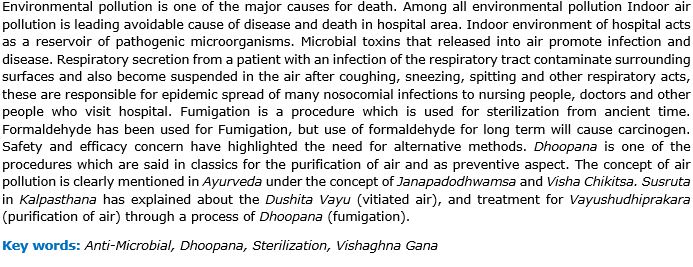Antimicrobial effect of Vishaghna Gana
DOI:
https://doi.org/10.21760/jaims.8.3.23Keywords:
Anti-Microbial, Dhoopana, Sterilization, Vishaghna GanaAbstract
Environmental pollution is one of the major causes for death. Among all environmental pollution Indoor air pollution is leading avoidable cause of disease and death in hospital area. Indoor environment of hospital acts as a reservoir of pathogenic microorganisms. Microbial toxins that released into air promote infection and disease. Respiratory secretion from a patient with an infection of the respiratory tract contaminate surrounding surfaces and also become suspended in the air after coughing, sneezing, spitting and other respiratory acts, these are responsible for epidemic spread of many nosocomial infections to nursing people, doctors and other people who visit hospital. Fumigation is a procedure which is used for sterilization from ancient time. Formaldehyde has been used for Fumigation, but use of formaldehyde for long term will cause carcinogen. Safety and efficacy concern have highlighted the need for alternative methods. Dhoopana is one of the procedures which are said in classics for the purification of air and as preventive aspect. The concept of air pollution is clearly mentioned in Ayurveda under the concept of Janapadodhwamsa and Visha Chikitsa. Susruta in Kalpasthana has explained about the Dushita Vayu (vitiated air), and treatment for Vayushudhiprakara (purification of air) through a process of Dhoopana (fumigation).
Downloads
References
Sushant Sukumar Baragale, H K Shashireka. Text book of Swasthavritta:1st edition, Chaukhambha publications, New Delhi;2016 pg415
Sharma Ravi. Air Born Diseases, Examples of Airborne Diseases and Its Prevention Methods: 2014 Dec 18, (cited on 8th January, 2023).
WHO. Prevention of hospital-acquired infections a practical guide 2nd edition; 2002. http://www.who.int/csr/resources/publications/drugresist/WHO_CDS_CSR_EPH_2002_12/en/- 21k (Cited on 28th January, 2023)
Susruta Samhita, kalpaSthana 3/16, translated by Murthy KRS. Varanasi: Chaukhambha Orientalia; 2012 (2ndvol).
Agnivesha, Charaka, Dridhabala. Charaka Samhita, Vimana Sthana3/6, Translated by Sharma RK, Vaidya Bhagwan Dash. Varanasi: Chowkambha Sanskrit Series Office; 2005 (2ndvol).
WHO. Prevention of hospital-acquired infections a practical guide 2nd edition; 2002. http://www.who.int/csr/resources/ publications/drugresist/WHO_CDS_CSR_EPH_2002_12/en/- 21k (Cited on 28th January, 2018)
Hussain Gazala. Dhupana Kalpas: A review. J Biol Sci Opin 2015; 3(3):157159. http://dx.doi.org/10.7897/2321-6328.03333 (Cited on 28th January, 2023)
http://www.geschkult.fu-berlin.de/e/babmed/konferenzen /Fumigation/ (Cited on 28th January, 2018)
The Importance of Fumigation in Ayurveda. (Cited on 13th march, 2016)
Sumitha L and Prasad BS: Evaluation of Antimicrobial and Antifungal Property of Dhoopana Karma (Fumigation) – By “Dhup” An AyurvedicDhoopana Product. Int J Pharm Sci Res 2015; 6(7): 2950-54.doi: 10.13040/IJPSR.0975-8232.6 (7).2950-54. http://dx.doi.org/10.13040/IJPSR.0975-8232.6(7).2950-54 (Cited on 28th January, 2023]
Shrestha, Sahara & Bedarkar, Prashant & J Patgiri, B &Chaudhari, Swapnil. (2017). Dhoopana Karma: A Review Through Brihatrayi. IAMJ. http://www.iamj.in/posts/images /upload/316 325.pdf (Cited on 28th January, 2023)















